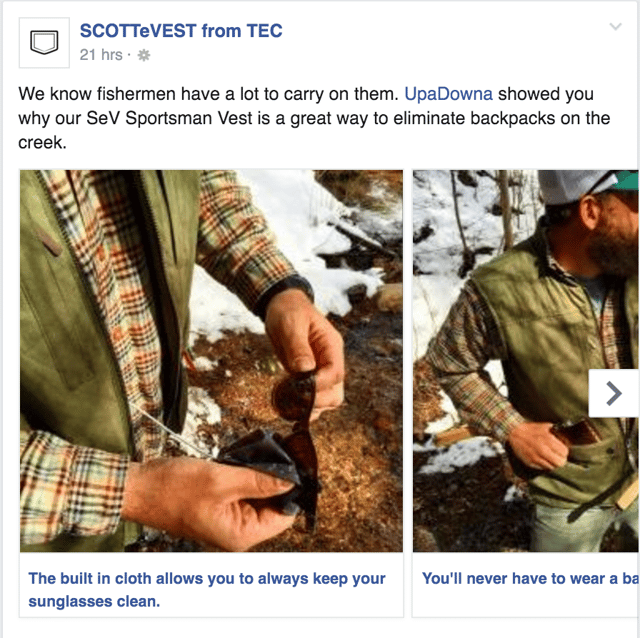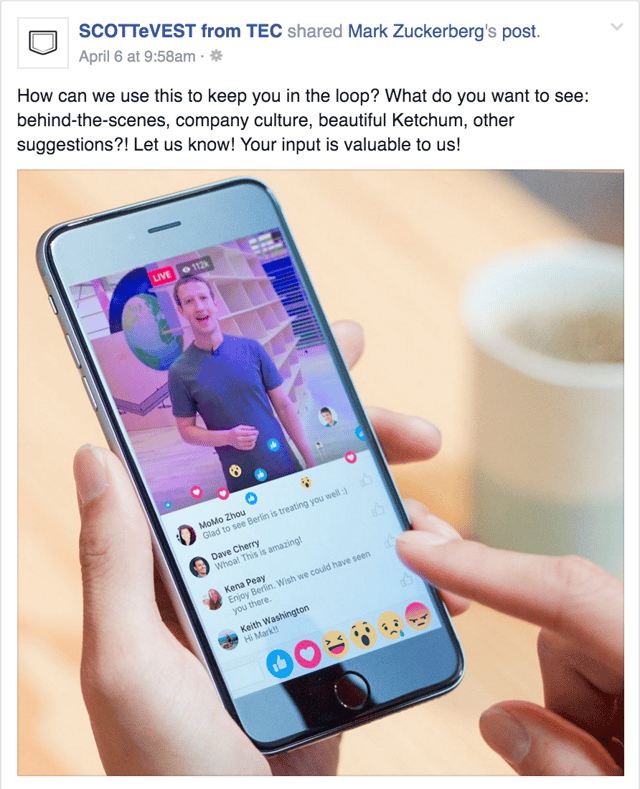Welcome back to our new series, Content Marketing Deep Dive, where we examine successful brands that consistently produce great content marketing. We'll cover what each brand does well and what you can learn from them, with 3 key takeaways you can begin applying to your content marketing efforts. We'll also take a look at how the brand could improve on their current efforts.
Today we're taking a look at how SCOTTeVEST uses social media to promote their content marketing efforts, both with video, images, and other content they've created, as well as content from 3rd parties like customers and online reviewers.
My analysis of SCOTTeVEST was a lot of fun to do. They are very well rounded with great content, excellent customer service, and a clear commitment to their community of customers. Still, I did find some room for improvement, and you can find my advice for how they could better utilize LinkedIn as a platform for targeting one of their specific personas at the end of this post.
Insight 1: Feature 3rd Party Reviews
"It seems very clear that SeV has personas matched with their product line, or at least understands the needs of the people they created their products for, and take that into account when sharing content related to that particular product."
Almost every brand that has been around for a at least a couple of years and has some customers will have reviews shared, either on their own social properties, or elsewhere on the Internet. SCOTTeVEST does a great job of putting the focus on great external reviews.
Engage reviewers and, with their permission, share these reviews on your own social properties. Of course from a legal standpoint you don't need permission, sharing a review posted online will generally be covered by fair use, but there are two good reasons that you want to have it anyway.
- Not everyone is comfortable with you sharing their review with your entire audience. To avoid any negative feelings from your reviewer, most likely a customer, it's always better to ask permission than to beg forgiveness.
- This also gives you an opportunity to coordinate with the reviewer. Those who don't mind you sharing it will probably be thrilled that something they created is being shared with a wider audience, and they're likely to share your post and tell their friends and family about it, providing a helpful boost in engagement and impressions for your post.
As for what you're actually sharing, that can range from anything as simple as a customer quote, maybe with a photo that compliments it, to a video showcasing your product, and even something as clever as SeV's link post with multiple photos highlighting individual features that the reviewers loved about their products!
And of course this post gets bonus points for also being targeted to a niche within their larger audience. It seems very clear that SeV has personas matched with their product line, or at least understands the needs of the people they created their products for, and take that into account when sharing content related to that particular product.

This was a great use of the relatively new ability to add multiple images to a single link post.
Image: Scottevest
KEY TAKEAWAYS FOR YOUR BRAND
- Don't be afraid of 3rd party reviews - Embrace them, feature them in your own content. It's a great way to showcase your products and add social proof. It's one thing for you to talk about how great your products are, it's a whole other ballgame for people to see your customers saying it.
- Get creative - Don't stop at sharing customer quotes in text posts. Find or encourage video reviews with a contest, create photos that showcase customer reviews with an image of the customer with their product, the quote on a landscape, or some other eye catching post that will grab the attention of your readers in their feeds.
- Don't forget your targeting - Reviews are a great opportunity to talk about the specific value that your product brings to people who fit within a particular persona. Figure out which persona your reviewer fits into, and then make sure that what you share speaks to the needs or interests of that persona.
Insight 2: Don't Be Shy, Ask Your Audience for Feedback
It's wise of SCOTTeVest not to assume that they know exactly what their customers want to see from them on social media. No matter how well you know your audience, how many insights you've cultivated over the years, and how often you interact with them, nobody will ever be able to tell you what they want better they can.
Of course, I'm not suggesting you get lazy and farm out every strategic content decision to your community, but it doesn't hurt to ask for feedback to kick start your own ideas or confirm your assumptions before moving forward.

SCOTTeVEST seems to have a content strategy, with a strong focus on featuring product reviews, customers using their products, and highlighting the most loved features of new and existing products. Still, they leverage their community's input when making decisions that might alter that strategy.
Image: SCottevest
KEY TAKEAWAYS FOR YOUR BRAND
- Have a plan, but be open to changes - You can't leave every decision to the whim of your audience, there is a limited social capital that you're asking your community to expend every time you ask them to do something more complex than liking a post or clicking a link. So, you definitely want a plan of your own, but it is a great idea to check in with your community to get their feedback when making key strategic content decisions.
- Pay attention to your community - Asking your community for feedback directly isn't the only way to learn what they like, as we've discussed before, you can gain a lot of insight from metrics that will teach you what your audience does and doesn't like about your content mix. You should be working to pull customer insights out of your metrics every week, not just when you ask them a direct question.
- But don't be afraid to ask - Sometimes there's just not enough data to make a decision on or you'll get conflicting signals from your community. In these cases especially, it's a good idea to ask your audience for their direct input.
Insight 3: Take Customer Service Seriously
We've already talked at length about how to use social customer service to retain customers and how to optimize the efforts of a small social customer care team, but even in 2016 many brands clearly don't take customer service seriously, despite the fact that 3 years ago 67% of consumers said they used social media for customer service and 33% said it was their preferred method of contacting a company for their customer service needs.
You can bet both of those numbers are even higher today.
Of course, that's why it's so refreshing to see not only a swift reply (around 30 minutes after the customer posted) to customer service issues after hours, promising a hassle free replacement of a damaged product, but also an after hours reply from the CEO along with it!

SCOTTeVEST clearly understands the value of social customer service.
Image: ScotteVest
KEY TAKEAWAYS FOR YOUR BRAND
- Don't ignore social media for customer service - The majority of consumers plan to use social media for customer service. Can you imagine just turning your customer service line off for a day for no reason? If you can't imagine doing that, I can't imagine why you would be okay with ignoring customer service issues on social media channels.
- Treat social as a primary customer service platform - Not only do a majority of your customers want to use social as a customer service platform, but your other customers and potential buyers can see when you're ignoring customer issues on social media. Whether that accurately reflects how your company approaches customer service as a whole or not, potential buyers will assume it does and will be less likely to buy from you. It bears repeating once again that customers often end up on social media when other support channels have failed them, not only is this your opportunity to impress prospective buyers, it's also likely your last opportunity to retain an existing customer.
- Respond quickly and be solution oriented - These points seem so obvious, but judging how many brands approach social customer service, they really must not be. 74% of consumers expect a response to their customer service issue on social media somewhere within a 30 minute to 60 minute window. Despite this expectation, they're also let down so often by brands that fail to meet that window that simply meeting their expectations here will often make them feel you've gone above and beyond in providing great customer service. It isn't hard, you just have to be committed to doing it.
How Could ScotteVest IMprove Their Content Marketing?
SCOTTeVEST does a great job with their content marketing across almost all of their platforms. It was actually really difficult to find an area that they could improve on in the limited time I can spend analyzing their content marketing efforts.
However, I did notice that SeV does seem to be severely under utilizing LinkedIn. It's not surprising, considering that most brand see it as a B2B only platform, but there are some great use cases that demonstrate B2C and retail businesses using the platform very effectively.
It seems pretty clear to me that one of SCOTTeVEST's personas is the business traveler. I remember when I bought mine a few years ago this was one of the major selling points that SeV talked about frequently in their marketing, the ability to keep everything in your jacket, drop it in one of those buckets and send it through the x-ray without having to rummage through your pockets at the security checkpoint. Even as recently as 4 days ago they're still talking about how great this is.
They also made an excellent video featuring Peter Shankman in November of 2015 that is also clearly meant to appeal to the needs of the traveling businessman, and they even have a sport coat for those of us who have to dress up when we travel.
LinkedIn would be a great place to target this persona, and thanks to LinkedIn's powerful targeting parameters they could even break this down by specific industries and by the jobs that require the most travel in each industry, and then create posts and targeted sponsored updates that would appeal to business travelers in each target industry.
Want to learn more about how to consistently create high quality content? Check out our Ultimate Guide to Content Marketing in 2016 and download our ebook on How to Write Great Blog Posts!
Tags:
Content MarketingApril 08, 2016

